Andrew Paul Wood – 29 December, 2019
The imagery is sourced from variety of places. It could be Extinction Rebellion or students rioting in Hong Kong. The specifics really don't matter because it is at once obvious what's going on. Soldiers and police, victims and uprising. Images of violence, protest and gas masks repeat as the central motifs throughout the work, timeless as much as they are timely. It's an appeal to emotion and morality, a metaphorical call to arms.
Having previously been shown in Leipzig, Germany and at the Suter in Nelson, Lisa Chandler’s The Dividing Line is an interesting work in that it manages to drive a strong political message without compromising on aesthetic and artistic integrity.
A product of Whitecliffe College of Arts and Design, Chandler divides her time between Leipzig and Golden Bay, having built up an impressive résumé of exhibitions and residencies over the last decade or so.
The imagery is sourced from variety of places. It could be Extinction Rebellion or students rioting in Hong Kong. The specifics really don’t matter because it is at once obvious what’s going on. Soldiers and police, victims and uprising. Images of violence, protest and gas masks repeat as the central motifs throughout the work, timeless as much as they are timely. It’s an appeal to emotion and morality, a metaphorical call to arms.
The Dividing Line is powerful stuff, and extremely impressive in a time when earnest figuration and narrative tend to be disregarded as liabilities in painting. It’s more of a step back, in a way, to the postmodern new history painting of the 1990s without once feeling stale or recycled.
The larger paintings are flatly executed in acrylic in a well-judged Baconesque palette of blues, greys and fleshy pinks, vigorously enlivened with sgraffito, scraping and even spray paint.
These are accompanied by a set of small monoprints encyclopaedically cataloguing variations on the gasmask, terrifying to behold, blank and skull-like. From Pink Floyd’s The Wall to Dr Who, the gas mask has become the pop-cultural face of mass, anonymous horror. Chandler deploys it with great effect to deliver surgical blows against comfortable complacency.
Superficially the style of the paintings owes much to pop art’s flat expressionistic slathers over a bricolage of charged imagery — Robert Rauschenberg in particular comes to mind — but beneath that is a humanist lifeforce, elegant melancholy and anger that seems to be channelling the wartime imagery of British neo-romantics like Eric Ravilious, or Henry Moore’s drawings of Blitzed London—and the raw anguish and frustration of German new objectivity.
At times the paintings strive for the status of trompe-l’œil graffiti with a nod to Banksy and a wink at Jean-Michel Basquiat that is just subtle enough not to be annoying. This is the legacy of installation art, the need to create a holistic environment for the viewer.
For all that, and one could easily go back further to Picasso’s Guernica, and Goya’s Third of May 1808, or even to Renaissance paintings of battles and massacres, this is resolutely contemporary painting, virtuosic at points, speaking to us in the here and now, taking its cue from the image and atrocity-saturated media bombardment by which we experience the world.
It makes you feel something in these jaded and empathetically fatigued times, and how often can you say that?
Andrew Paul Wood

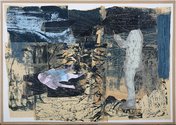
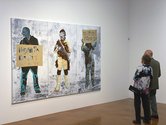

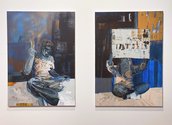
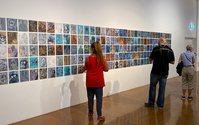


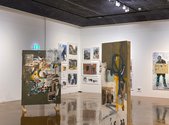
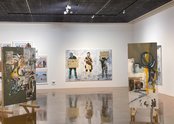

 Two Rooms presents a program of residencies and projects
Two Rooms presents a program of residencies and projects Advertising in this column
Advertising in this column



This Discussion has 0 comments.
Comment
Participate
Register to Participate.
Sign in
Sign in to an existing account.